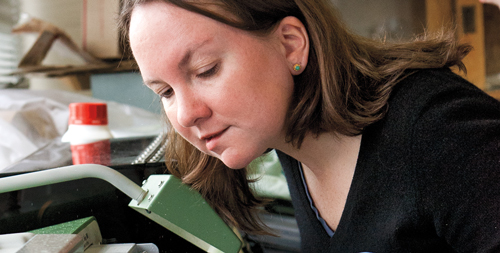When it comes to treating depression and anxiety, one type of drug is the most effective and most commonly prescribed: selective serotonin reuptake inhibitors, or SSRIs. This class of drug includes widely known brands such as Prozac and Zoloft, as well as dozens of others. But despite their prevalence, scientists don’t know exactly how these drugs work.
Researchers have a term for such systems, in which the inputs and outputs are clear but the mechanisms remain inscrutable: “black boxes.”
The hows and whys might not matter, except that SSRIs have a dark side. Patients who start taking them can initially experience an increase in anxiety. For some reason, teenagers seem especially prone to this phenomenon. Sometimes it can make them suicidal.

“I’m interested in what cells are activated by these drugs
and how those cells interact with the fear circuitry,” Bauer says.
Some SSRI packaging, therefore, displays the FDA’s most serious warning, for drugs with potentially lethal side effects. This happens to be called a “black box warning,” because it appears inside a bold, black rectangle.
Liz Bauer ’97 is targeting both of these black boxes. She wants to find out what, exactly, SSRIs are doing in the brain, and thereby help doctors and drug companies learn how teenagers can safely take them. “I’m interested in what cells are activated by these drugs and how those cells interact with the fear circuitry,” she says.
Bauer is an assistant professor at Barnard College in New York, where she uses rats as her test subjects. Her research has already revealed something new about how SSRIs work.
When Bauer started her work on the drugs, she expected a particular part of the brain usually associated with fear and anxiety—the amygdala—to be responsible for the initial increase in anxiety. But she and her team saw no heightened activity in the amygdalae of rats that had been given Prozac. “It was surprising,” she says. “We thought we would find something there.”
Instead, they discovered that SSRIs seem to be acting on cells in a related but separate structure known as the BNST—the bed nucleus of the stria terminalis.
This was something new. “Until we published the paper,” she says, “we were the only ones who knew” about the BNST’s involvement in this problematic side effect of SSRIs.
Now she’s delving deeper into the BNST. Using extremely thin slices of brain—only a few cells thick—Bauer is looking at individual brain cells of rats treated with SSRIs. “You can ask all these different questions,” she says: “What are the cells doing? Which cells are active? What are their characteristics?”
Down the road, she hopes to figure out how exactly the BNST communicates with the amygdala. While it will take more research before pharmaceutical companies can use her work to design safer drugs, Bauer hopes that, eventually, her work will help unlock the black box of SSRIs—and banish the black box warning from their labels for good.
Geoffrey Giller ’10 is a science and environmental writer. His work has appeared in Audubon and Scientific American, among other publications. Photo by Geoffrey Giller.